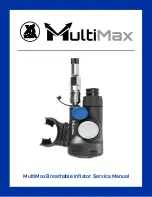
Step 1: Dolly & Coating Preparation
Step 1: Dolly & Coating Preparation
Dolly Preparation
1.
To remove oxidation and contaminants, place the included abrasive pad on a
flat surface and rub the base of the dolly across the pad 4-5 times.
2.
As required, remove residue left from the abrading process using a dry cloth
or paper towel.
Coating Preparation
1.
Lightly roughen the coating using the included abrasive pad.
As coating abrasion may introduce flaws, it should only be used when
necessary to remove surface contaminants, or when the bond strength between the
adhesive and the coating is insufficient for pull testing.
2.
To promote the bond between the dolly and the coating, degrease the area of
the coating to be tested using alcohol or acetone to remove any oil, moisture or
dust.
Ensure that any alternative abrasion techniques, degreasers or adhesives
do not alter the properties of the coating. Test by applying a small amount of
degreaser or adhesive to a sample area and observing effects.
Step 2: Adhesive & Dolly Application
Step 2: Adhesive & Dolly Application
Adhesive Selection
The adhesive included in the PosiTest Adhesion Tester kit has been selected due
to its versatility. This adhesive has minimal impact on a variety of coatings and has
a tensile strength exceeding the maximum performance capabilities of the pressure
system under ideal conditions. Other adhesives may be preferred based on
requirements such as cure time, coating type, working temperature and pull-off
strength. Quick curing one-part cyanoacrylates (super glues) may be sufficient for
painted surfaces, but two-part epoxies are preferred for porous or rough coatings.
Dolly Application
1.
Mix the adhesive per manufacturer’s instructions and apply a uniform film of
adhesive on the base of the dolly (approximately 2-4 mils or 50-100 microns
for best results)
2.
Attach the dolly to the prepared coating test area.
If the coated surface to be tested is overhead or vertical, a means to
hold the dolly in place during the cure time may be required, i.e. removable tape.
Page 4
NOTE:
NOTE:
NOTE:





























